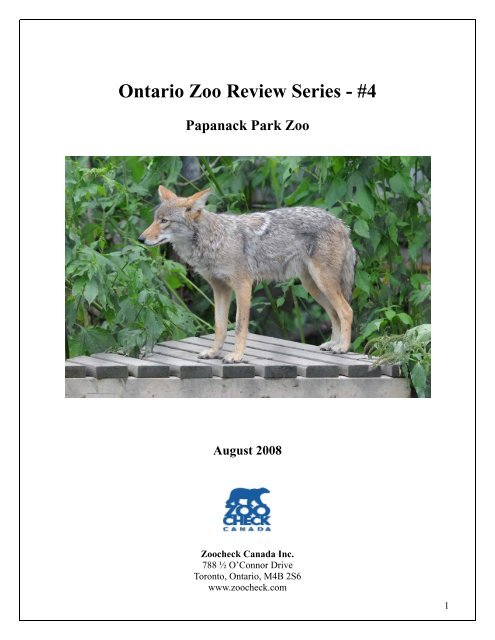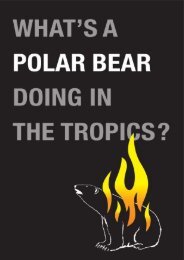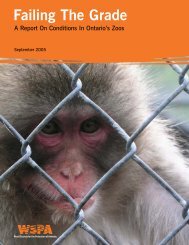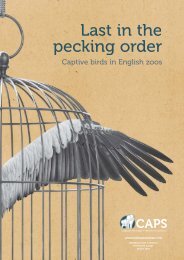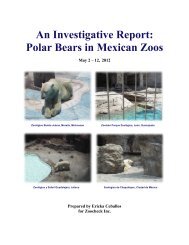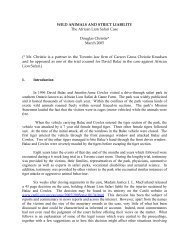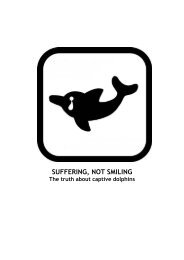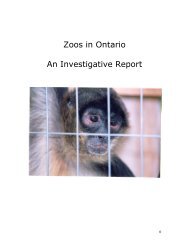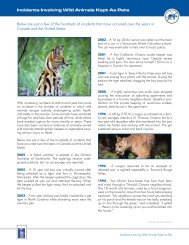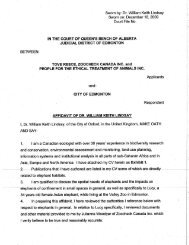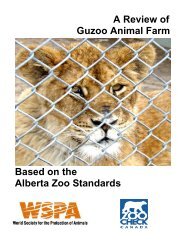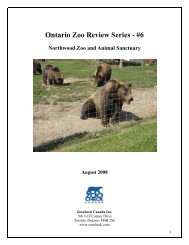Papanack Park Zoo - Zoocheck Canada
Papanack Park Zoo - Zoocheck Canada
Papanack Park Zoo - Zoocheck Canada
Create successful ePaper yourself
Turn your PDF publications into a flip-book with our unique Google optimized e-Paper software.
Ontario <strong>Zoo</strong> Review Series - #4<br />
<strong>Papanack</strong> <strong>Park</strong> <strong>Zoo</strong><br />
August 2008<br />
<strong>Zoo</strong>check <strong>Canada</strong> Inc.<br />
788 ½ O’Connor Drive<br />
Toronto, Ontario, M4B 2S6<br />
www.zoocheck.com<br />
1
ZOOCHECK CANADA INC.<br />
<strong>Zoo</strong>check <strong>Canada</strong> is a national animal protection charity (#13150 2072 RR 0001) established in 1984 to promote<br />
and protect the interests and wellbeing of wild animals.<br />
Policy<br />
<strong>Zoo</strong>check objects in principle to the keeping, confinement, use, exhibition and performance of wild animals in<br />
captivity as captivity is not in the best interests of those animals 1 . Nor does the exhibition of live wildlife<br />
provide a positive educational experience for the general public. Wild animals removed from their natural<br />
environment and ecological context bear little or no meaningful resemblance to their counterparts in the wild.<br />
Nonetheless, animals are kept in zoos and similar captive situations at present and for these animals,<br />
improvements in the conditions to which they are subjected are urgently needed. <strong>Zoo</strong>check believes the onus<br />
must be on the owners/operators of facilities who choose to keep these animals captive, to provide for them the<br />
best possible care in the circumstances.<br />
The Investigation<br />
This report provides an overview of the <strong>Papanack</strong> <strong>Park</strong> <strong>Zoo</strong> in Wendover, Ontario on August 13, 2008.<br />
It is the fourth in a series of investigative reports aimed at providing a snapsnot image of the current<br />
status of captive wild animals in Ontario.<br />
Investigator Profile<br />
In 1978 Else Poulsen received her BSc. in Biology from Brock University and in 1995 her 4 year Diploma in<br />
<strong>Zoo</strong>keeping from the City of Calgary Apprenticeship Programs. She has dealt with variety of animal species, in<br />
her work as a field biologist in Alberta’s energy industry, as a zookeeper at the Calgary <strong>Zoo</strong>, and as a bear<br />
specialist in several other facilities.<br />
She has provided expert assistance and advice about modernizing bear husbandry methods, environmental<br />
enrichment programming and enclosure design issues to zoos, sanctuaries and animal welfare groups around the<br />
world.<br />
Poulsen has more than 40 papers and articles to her name in scientific research and technical journals, textbooks<br />
and other publications. She consults as an animal behavior and captive environment trouble-shooter. She has<br />
also lectured on modern bear care and animal welfare issues to audiences as diverse as university students<br />
studying population genetics to First Nations Band Council members in northern <strong>Canada</strong>.<br />
1 In limited circumstances, exclusively for the purpose of benefiting the individual animal or species, <strong>Zoo</strong>check <strong>Canada</strong><br />
supports the keeping of wild animals in captivity as part of a legitimate rehabilitation and release program, or for nonreleasable<br />
animals that have been retired or rescued, or that are part of a legitimate captive propagation initiative, provided<br />
the animal's physical, psychological and social needs are addressed as the primary concern.<br />
2
THE SITUATION IN ONTARIO<br />
There are currently few rules governing the operation of zoos and other kinds of captive wildlife displays in<br />
Ontario. This lack of regulation has resulted in a proliferation of zoos and zoo-type exhibits in the province.<br />
Ontario has more of these facilities than any other province, including many of the worst in <strong>Canada</strong><br />
Unlike many other jurisdictions, in Ontario, non-indigenous exotic wildlife species are not regulated. Virtually<br />
anyone can acquire exotic wild animals, house them in conditions of their choosing and then open up for public<br />
viewing. There are no laws or regulations requiring the owners or operators of zoos to have expertise or<br />
experience in wild animal care, the financial resources to properly operate their facility or an ability to conduct<br />
their business in a humane and safe manner.<br />
"Specially protected and game wildlife," defined as native wildlife listed in the Fish and Wildlife Conservation<br />
Act, can only be kept and displayed if a license to do so has been obtained from the Ontario Ministry of Natural<br />
Resources (MNR). Three general animal welfare conditions are attached to all licenses, but they are not specific<br />
and are open to interpretation, so enforcement is problematic.<br />
Ontario’s lack of zoo licensing and comprehensive wildlife in captivity standards has resulted in a large number<br />
of zoos and wildlife menageries operating at a standard of their own choosing. There is nothing in place that<br />
specifically addresses the many issues associated with the capture, breeding, keeping and display of wild animals<br />
in zoos and zoo-type exhibits.<br />
The unfettered proliferation of wild animal displays in Ontario has been recognized as a problem for<br />
approximately 30 years. Numerous measures to deal with this issue have been initiated, but none have been fully<br />
supported by government, so the captive wildlife industry remains essentially unmonitored and uncontrolled to<br />
this day.<br />
The Government of Ontario has the ability to create a regulatory regime for all wildlife in captivity that is<br />
consistent with other jurisdictions, comprehensive, fair to license holders and respectful of the many individual<br />
animals whose lives are directly affected by it. In addition to numerous workable and adaptable models being<br />
available in other jurisdictions, in 2001, the MNR published its own set of standards for zoos.<br />
Comprehensive Licensing and Regulation is Required<br />
The Ontario government should implement and administer a comprehensive zoo and wildlife in captivity<br />
regulatory program that requires anyone holding native and/or exotic wild animals in captivity to obtain a license<br />
and to satisfy a series of conditions as to their knowledge, experience, financial abilities, wild animal housing<br />
and management practices, safety procedures and other relevant issues. Licenses should be issued annually and<br />
only after an inspection of the premises to be licensed is conducted. The regulatory program should include the<br />
ability to conduct special inspections, penalties for non-compliance and provisions for license revocation.<br />
Bill 50, An Act to amend the Ontario Society for the Prevention of Cruelty to Animals Act<br />
In 2008, the Ontario government introduced Bill 50, An Act to amend the Ontario Society for the Prevention of<br />
Cruelty to Animals Act. During the buildup to the introduction of the Act, government officials and elected<br />
representatives said the Act would deal with a variety of animal welfare issues, including roadside zoos.<br />
Bill 50 would:<br />
• Make it a provincial offence to abuse any animal. Ontario is the only province where it is not an offence<br />
to abuse most animals. It is only an offence to abuse cats and dogs in commercial breeding operations.<br />
• Establish penalties including a lifetime ban on owning animals.<br />
3
• Allow the Ontario SPCA to inspect roadside zoos and other facilities that keep animals. Currently,<br />
anyone can refuse to show the Ontario SPCA their animals.<br />
• Establish animal care standards and make failing to comply with these an offence.<br />
While Bill 50 contains a number of very positive features and will significantly improve the existing Ontario<br />
SPCA Act, it will not address most of the problems that have been identified in zoos and zoo-type exhibits<br />
across the province.<br />
Even though the Ontario government has repeatedly indicated its intent to deal with wildlife in captivity issues<br />
through Bill 50, there are currently no standards or regulations being proposed at this time. If standards of some<br />
kind are developed in future, they will not contain up front licensing of zoos and zoo-type exhibits that screen<br />
persons wanting to own wild animals or open public displays. Standards promulgated under Bill 50 will be<br />
enforced retroactively after animals have been acquired or a zoo or wildlife display opened.<br />
If, as the Government of Ontario has stated, Ontario is to move from "worst to first" in animal protection, then<br />
Bill 50 must include comprehensive regulations for zoos. With the weakest zoo regulations in the country,<br />
Ontario is the only province that does not require zoos and zoo-type facilities to meet specific public safety<br />
requirements and does not require residents to obtain a license to keep exotic wild animals.<br />
The lack of appropriate laws and regulations, and the difficulties inherent in enforcing the existing relatively<br />
minor welfare provisions attached to licenses issued under the Fish and Wildlife Conservation Act, mean that<br />
Ontario’s zoos and wildlife exhibits go more or less unchecked. This has left a need for independent animal<br />
welfare agencies, such as <strong>Zoo</strong>check <strong>Canada</strong> and the World Society for the Protection of Animals (WSPA), to<br />
proactively and comprehensively monitor and evaluate these facilities for concerns of human health and safety<br />
and animal welfare.<br />
4
COMMENTARY – <strong>Papanack</strong> <strong>Park</strong> <strong>Zoo</strong><br />
General<br />
The <strong>Papanack</strong> <strong>Park</strong> <strong>Zoo</strong> was evaluated in September 2001 by the World Society for the Protection of Animals.<br />
Problems identified at that time included, but were not limited to, enclosure size, a lack of species-specific<br />
enclosure design and a lack of meaningful enrichment (e.g., furnishings, objects).<br />
Although problems were still in evidence, the zoo appears to be making some effort to replace old cages with<br />
larger, more natural enclosures. As well, they seem to have started an environmental enrichment program and are<br />
making an attempt to utilize more vertical space in the cages. A conservation education program for visitors is<br />
also more developed.<br />
Several of the newer cages for potentially dangerous species feature high fencing with an inverted overhang at<br />
the top, underground skirting to prevent escape by digging and adequate visitor stand-off barriers. A facility<br />
perimeter fence was observed, although I was unable to determine if the entire property is enclosed.<br />
While improvements appear to have been made since the WSPA evaluation, a number of enclosures remain<br />
undersized, several feature inappropriately thin gauge wire barriers and environmental enrichment is still<br />
underdeveloped. As well, the animals appear to be fed in “single pile” feedings once per day in the same<br />
location, a feeding method that does little to encourage activity in the animals.<br />
Husbandry and Animal Welfare<br />
One of the more obvious problems at <strong>Papanack</strong> <strong>Park</strong> <strong>Zoo</strong> is the lack of a zoo-wide environmental enrichment<br />
program. Upon entering the zoo, I encountered a number of small enclosures housing various monkey species<br />
and a coatimundi. These enclosures are moderately well-equipped and provide the animals with things to do. I<br />
imagine they give zoo visitors a good first impression. However, that good impression turns to disappointment as<br />
the enrichment wanes to nothing by the time the visitor reaches the arctic wolf exhibit finding barren conditions<br />
and animals that have little to do except sit or lie around.<br />
In conversations with <strong>Papanack</strong> <strong>Park</strong> <strong>Zoo</strong> staff, I learned that:<br />
1. Most animals are fed in single, piled feedings once per day, either placed in the same location within each<br />
enclosure or in the case of large carnivores (where shifting animals may be problematic) by throwing food items<br />
(e.g., meat) over the fence. While this feeding method is convenient, it greatly reduces enrichment and activity<br />
opportunities for the animals, as well as time spent with keepers which, in some cases, may also serve as<br />
enrichment.<br />
2. Except for the tigers (who are apparently hand-raised for shows), the large carnivores (and other animals) are<br />
sometimes difficult to shift because the keepers have not trained them to shift for feeding or veterinary purposes.<br />
Therefore, when shifting is required for cleaning or repair, food may be partially or wholly withheld for a few<br />
days to make the animal hungry enough to move into a holding area. This kind of management regime is “old<br />
school.” In many modern zoos it has been replaced with the organized development of the animal-keeper bond<br />
and with training animals so they shift willingly and present body parts for veterinary procedures (e.g., blood<br />
draws, inspections).<br />
3. One zookeeper informed me that hand-rearing of cats was practiced. They said big cat females are not good<br />
mothers, so hand-rearing was necessary. However, hand-raised females often become poor mothers themselves<br />
because they have not learned how to appropriately care for young. Removing tiger cubs and other young<br />
animals from their mothers and hand-raising them may hinder their social development during a particularly<br />
critical period of their lives. It is a questionable practice that may have detrimental, long-term consequences. As<br />
5
well, trauma and stress may be experienced by the mother when her cubs are removed.<br />
Other problems include:<br />
• Several animals (e.g., eland, snow leopard) were observed pacing in a repetitive fashion and well worn<br />
pathways, presumably the result of pacing, were observed in many enclosures (e.g., leopard).<br />
• Visitors can purchase feed for certain animals. Allowing visitors to feed animals can result in dietary<br />
imbalance; promote unwanted, abnormal begging behaviours; lead to unsafe human-animal interactions<br />
and; increase the potential for zoonotic disease transfer.<br />
• A general lack of nesting/denning material, although there were prodigious amounts of straw covering<br />
cage floor surfaces at the time of this inspection, presumably a measure to dry up some rainwater that<br />
seemed to saturate some of the enclosures.<br />
• According to one staff member, White-handed gibbons, squirrel monkeys and other animals that are<br />
unable to cope with <strong>Canada</strong>’s cold winters are warehoused in an off-site barn for a number of months<br />
each year.<br />
Safety and Security<br />
• The inwardly angled upper portion of the white tiger enclosure fence was sagging considerably in<br />
places.<br />
• During my visit, a young zookeeper was observed shouting at a “vocalizing” adult white tiger that was<br />
in the same building. Shouting at animals and/or loss of composure is often a red flag that a zookeeper is<br />
not well trained, confident or feeling safe, especially when working with potentially dangerous animals.<br />
• No double door entry gates (a standard safety measure on animal cages) were observed.<br />
• The gauge of wire in the fencing used to confine some of the hoof-stock (e.g., buffalo) and several large<br />
carnivores (e.g., cougar) appeared inappropriately small.<br />
• There are tires tied together with ropes weighting down a tarp covering a large pile of hay in an occupied<br />
hoof-stock yard. This is potentially dangerous to the animals as they could get their horns, antlers or legs<br />
caught in the ropes.<br />
• A number of the locking mechanisms appeared rusty and old. A stick was holding a gate closed at the<br />
snow leopard exhibit.<br />
• A picnic table was located against the visitor stand-off fence behind the tiger enclosure. A visitor could<br />
easily hop onto the table to facilitate entry into the restricted area at the rear of the exhibit.<br />
• Animal foods delivered throughout the zoo were sometimes uncovered. I observed food containers left<br />
standing, attracting flies and other pests.<br />
• Visitors are encouraged to feed some animals and can buy food to do so. They are instructed how to hold<br />
the food to avoid being bitten. Despite the fact that <strong>Papanack</strong> <strong>Park</strong> <strong>Zoo</strong> facilitates interactions between<br />
visitors and the animals, I did not observe any hand-wash stations or any information about the<br />
importance of washing hands after petting animals as a disease prevention measure.<br />
6
Public Education<br />
The facility provides ample and consistent signage throughout that interprets key biological and conservation<br />
facts about individual species. Visitors can also pick up a pamphlet and a zoo Map & Guide. Interpretive<br />
programs, such as carnivore feeding sessions, are listed. These feeding programs are delivered by the keepers<br />
who answer questions both before and after the feeding. For the most part, the information provided was<br />
accurate.<br />
During the Junior <strong>Zoo</strong>keeper Camp I observed a staff member holding an African hedgehog as a contact animal.<br />
Children were sitting in a circle and the hedgehog was placed on the ground in the center of the circle. The<br />
hedgehog appeared frightened and tried to escape the circle, but his attempts were not successful.<br />
I spoke to four zookeepers during my visit, all of whom had time to stay and chat at length. Since enrichment<br />
programming is underdeveloped, in my opinion it would be more productive if two of those keepers spent time<br />
delivering enrichment, instead of talking to zoo visitors. This is a small facility, so two staff dealing with visitors<br />
should be sufficient.<br />
Summary<br />
The <strong>Papanack</strong> <strong>Park</strong> <strong>Zoo</strong> seems to be going through the same process that many larger municipal zoos have in the<br />
past. They appear to be in the middle of a learning curve that is taking them toward better animal welfare.<br />
In building their new enclosures <strong>Papanack</strong> <strong>Park</strong> <strong>Zoo</strong> needs to consider adding smaller outdoor pens (howdy<br />
cages) which abut their main enclosures to accommodate low stress animal introductions, training for veterinary<br />
reasons and separation when needed. As well, the zoo needs to pay better attention to the spatial needs of<br />
animals.<br />
Relatively bland cage interiors are a problem. Introducing a zoo-wide enrichment program would go a long way<br />
to alleviating boredom, stress and promoting better animal care at relatively low cost. Bringing enrichment into<br />
the zoo involves changing their apparently outdated feeding routines and training staff how to shift animals using<br />
positive reinforcement, as well as introducing furnishings, objects, management regime changes and other<br />
measures. Visitors enjoy watching animals that are actively engaged in normal behaviours.<br />
7
Several primate enclosures near the zoo entrance are fairly well equipped furnishings.<br />
These tires and ropes may pose a hazard to the hoofstock.<br />
8
Public feeding of animals can disrupt animal diets and may pose a hazard to visitors.<br />
Hoofstock paddocks are plain and some are not equipped with visitor stand-off barriers.<br />
9
Cage furnishings are rudimentary, well worn and in need of replacement.<br />
Hardpan (compacted earth) paths, such as the one in this tiger cage,<br />
are usually created by pacing and are often a sign of lack of activity and boredom.<br />
10
The overhang portion of this tiger enclosure fence is sagging.<br />
The furnishings in this tiger enclosure are basic, should be upgraded.<br />
There are also few shelter and privacy areas.<br />
11
CONCLUSIONS & RECOMMENDATIONS<br />
This series of investigative reports highlight animal welfare and human safety concerns in zoos and<br />
wildlife displays across the province.<br />
Key problems identified in Ontario zoos in 2008 include:<br />
1. Poor animal health and welfare;<br />
2. Undersized, badly constructed, poorly designed cages and enclosures;<br />
3. Inappropriate substrates (floor surfaces);<br />
4. Lack of adequate shelter and privacy;<br />
5. Lack of stimulation (e.g., furniture, objects, other enrichment);<br />
6. Lack of nutritive food and potable water;<br />
7. Inadequate safety and security measures.<br />
Many of these problems have been identified in previous reports by various parties in past years.<br />
Recommendation<br />
Bill 50, An Act to amend the Ontario Society for the Prevention of Cruelty to Animals Act is currently<br />
being considered by the Government of Ontario. It contains a number of very positive features and will<br />
significantly improve the existing Ontario SPCA Act. However, there are currently no standards or<br />
regulations being proposed at this time within Bill 50 or in any other provincial legislation that will<br />
properly address issues associated with the keeping of wildlife in captivity. Ontario has the ability to<br />
create a regulatory regime within Bill 50 and in other legislation that is both comprehensive and<br />
workable but, so far, has chosen not to do so.<br />
In order to properly handle the various animal welfare and human safety concerns inherent in the<br />
operation of zoos and wildlife displays, a comprehensive regulatory regime is required. Regulations<br />
must require anyone holding native and/or exotic wild animals in captivity to obtain a license and to<br />
satisfy a series of conditions as to their knowledge, experience, financial abilities, wild animal housing<br />
and management practices, safety procedures and other relevant issues. Annual licenses should only be<br />
issued after an inspection of the premises that is to be licensed is conducted. The regulatory program<br />
should include the ability to conduct special inspections, penalties for non-compliance and provisions<br />
for license revocation.<br />
If, as the Government of Ontario has stated, Ontario’s animal protection laws are to be brought from<br />
“worst to first,” then Bill 50, An Act to amend the Ontario Society for the Prevention of Cruelty to<br />
Animals Act must include comprehensive zoo regulations that adequately and proactively address<br />
animal welfare and human safety concerns in Ontario zoos and wildlife displays.<br />
12


